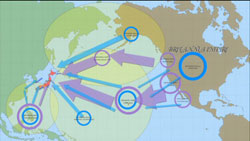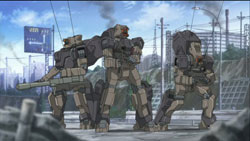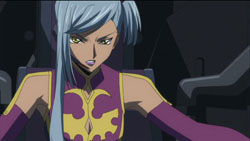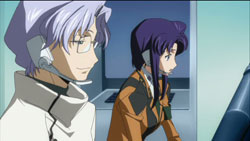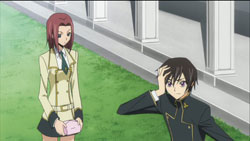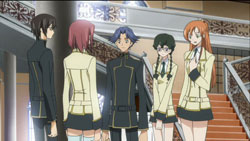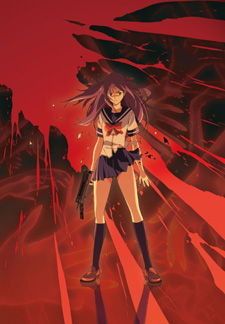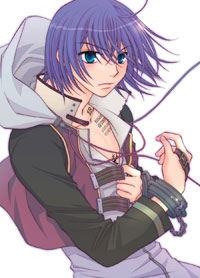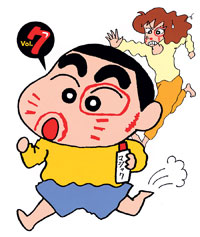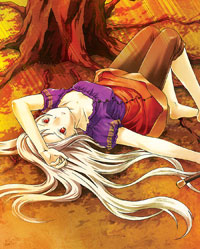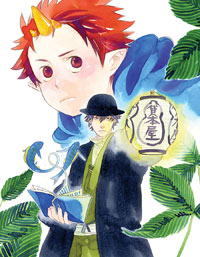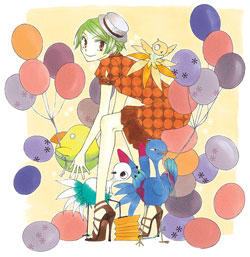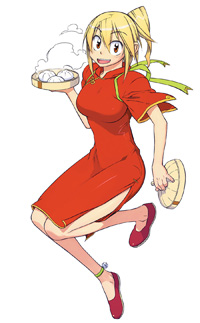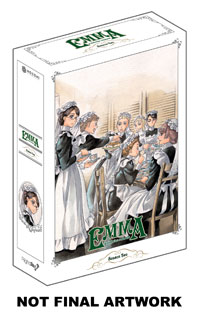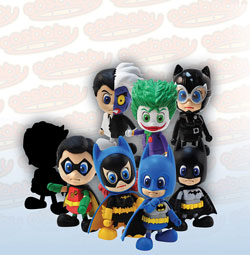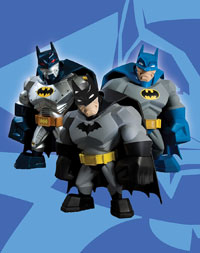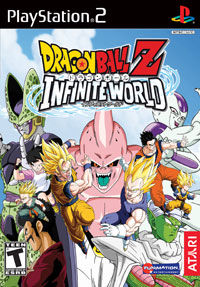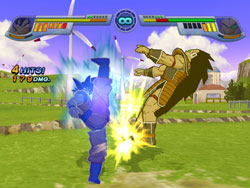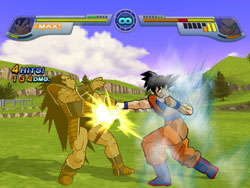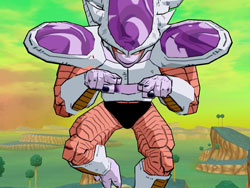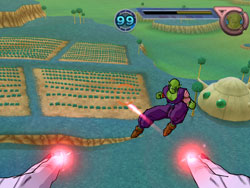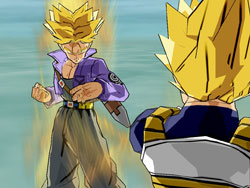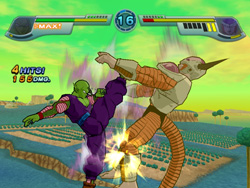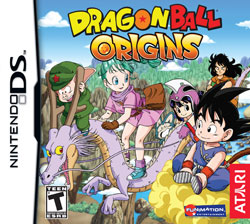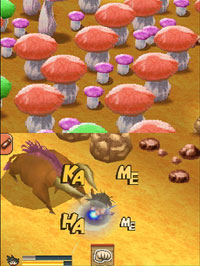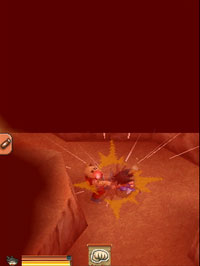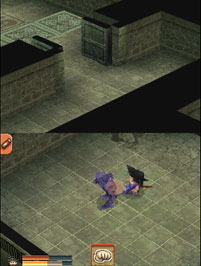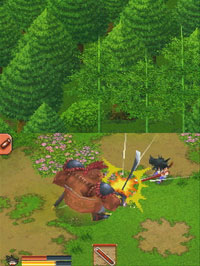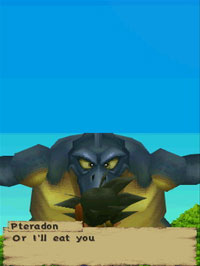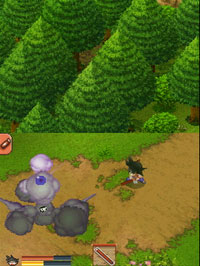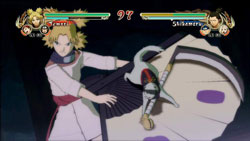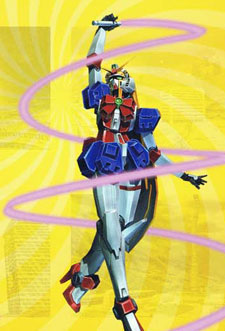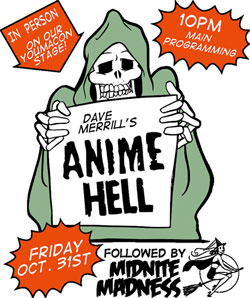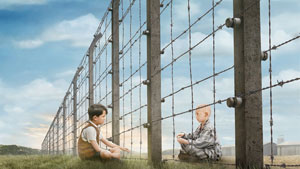 Logo handmade by Bannister
Column by Scott Green
Logo handmade by Bannister
Column by Scott Green
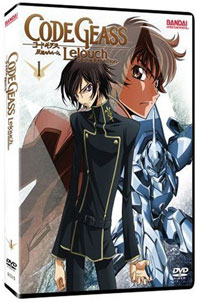
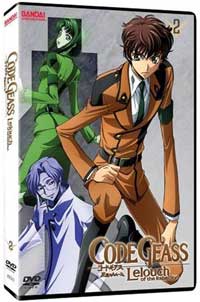
Anime Spotlight: Code Geass: Lelouch of the Rebellion Volumes 1 and 2 Released by Bandai Entertainment
Code Geass is a work of pan-allure. The prime ambition behind the series seems to be to appeal to absolutely every potential anime viewer. Simply put, the list of X meets Y meets Z that one could sputter out in describing Code Geas is both staggeringly long and diverse. Or, to get more elaberate, it features character designs by manga sensation CLAMP (Card Captor Sakura, xxHoLiC, Chobits)... quasi-realistic robots by Akira Yasuda (best known for his Capcom design work on the Street Fighter series, Power Stone, and Tech Romancer among others) and Kenji Teraoka (Ghost in the Shell: Stand Alone Complex)... There's an intellectually brilliant but morally compromised, if not outright dubious hero (comparisons to Death Note are unavoidable)... Complex military tactics... Geo-politics and Machiavellian intrigue... The wackiness and the psychological depth of elite school personalities (as in Revolutionary Girl Utena)... History has demonstrated that judging the success of a Sunrise mecha anime by its first set of episodes is a risky proposition. Series that have started slow, have locked into dynamic fast tracks. Conversely, series that have opened strong have abandoned their promise. I've certainly been both rewarded by the former and burned by the latter. Two volumes/nine episodes in, I'm willing to say that Code Geass shows all signs of delivering on it's ambitions and successfully annealing its range of ingredients. Series director Goro Taniguchi and writer Ichiro Okouchi have worked on a number of underrated or overlooked anime, including their previous collaboration Planetes, the hard sci-fi concerning orbital debris removal crews. Both have shown skill working with the human dimension and with the spectacle of anime. In this early, establishing phase of Code Geass, the pair demonstrates a solid grasp on the disparate elements with which they are working. While the anime goes from assassination and massacre in one scene to campus hijinx the next, the threads are woven together into a tapestry rather than splatter painted across its canvas.There's a notion of "neo-shonen" that has been forwarded by the commentators at Anime World Order. It applies to an evolution in manga, where the makers of shonen, boys', manga recognized that female audiences were buying shonen anthologies due to that secondary audience's interest in an aesthetic in male characters. In response shonen manga editors and creators ensured that characters who met that aesthetic were prominently featured and included in subtextual romantic interest. To quote a post on Anime News Network: By "neo-shonen," I mean most any shonen series made after 1987 where specific considerations were taken to appeal to female readers as well as males. Unlike practically every other Shonen Jump property since Saint Seiya, Fist of the North Star fandom isn't being kept alive by legions of fujoshi because there's nothing deliberately put in there to hook them, no matter how many manly tears are shed while shirtless. A similar diversification has happened in anime. When considering long anime series, there's the interminable children/family series (Anpanman, Doraemon and Sazae-san) that are running after thousands of episodes; there's the Shonen Jump adaptations (Dragon Ball, Bleach, Naruto, Detective) that run in the hundreds of episodes; there are the miscellanious exceptions (for example, legend of Galactic Heroes, which ran 110 OVA episodes, plus another 52 side story episodes). Not to offer an exhaustive list, but the final, and in this case, relevant, thread in longer anime is the Sunrise produced mecha anime, which generally run around 50 episodes. These include the Gundam franchise, other anime mecha shows from Gundam creator Yoshiyuki Tomino (Invincible Super Man Zambot 3, Space Runaway Ideon, Combat Mecha Xabungle, Aura Battler Dunbine), Ryosuke Takahashi's works (Armored Trooper Votoms, Fang of the Sun Dougram), a selection of classic super robot shows such as Brave Raideen and the Brave omnibus of the 90's (wrapped with The King of Braves GaoGaiGar). Code Geass is a refined step in the process of shaping the 50 episode mecha anime into something for as many audiences as possible, rather than merely just the action figure coveting school boy or card caring mecha obsessed. Look at the last 15 years of Gundam. The franchise started as a "real robot" series, attempting to inject an element of plausibility into the premise of a piloted fighting robot. In theory, the subject machinery were supposed to be military developed weapons systems rather than colorful power-totems. 1994 brought the first "alternate universe" Gundam, with Mobile Fighter G Gundam recasting the Gundam war as a wuxia serial starring colorful super robots. 1995 saw Mobile Suit Gundam Wing bring "neo-shonens" attractive male characters, and a heightened emphasis on emotional drama into the mix. 1996's tried to play with conventions of post apocalyptic/Mad Max action in After War Gundam X, and 99's worked with futurism and alternate or cyclical history in Turn A Gundam. Then, in 2002, the effort to broaden the appeal of Gundam took shape with Mobile Suit Gundam SEED, which retold a variant on the twisting war story established in 1979's original Mobile Suit Gundam, with the aesthetic established by Gundam Wing and an extensive, teenage ensemble cast. To borrow a mecha anime metaphor, Code Geass is the upgraded prototype, brought out late in the anime with hopes of giving the hero the power to win the war. It is obviously not the next Gundam, but, it was broadcast on Japanese TV in two 25 episode seasons almost alternating with Mobile Suit Gundam 00. Code Geass is set in the 21st century of an alternative timeline in which the super powers contesting for global dominance are the Holy Empire of Britannia (which includes the geographic bounds of the United States of America), the EU and China. As the world's leading supplier of the superconductor sakuradite, Japan became a target for Britannia's aggression. On August 10th, 2010, Britannia attacked, and with the aid of advanced humanoid armors known as Knightmare Frames, conquered the nation after a month long campaign. Redubbed "Area 11", Japan was stripped of its name, pride and heritage. It's people, the 11's, were reduced to second class citizens, living in slums or serving resettled Britannians. As a child, exiled Imperial Prince of Britannia Lelouch Lamperouge promised to destroy the empire for what is contests of heredity did to his mother and sister, and made a similar promise to the son of Japan's deposed Prime Minister in the wake of Britannia's invocation. As a teen, he adopted the personality of a bright underachiever at the Ashford Academy for elite ex-pats, while passive-aggressively taking revenge by hustling high-ups in chess game bets and privately seething that one day he'd set his intellect towards destroying them all. Lelouch's opportunity to take action is set into motion when he stumbles into the path of a cell of Japanese liberation terrorists stealing what was supposed to be a transport of Knightmare Frames, but which the Britannian military believes is a shipment of poison gas. The conflict between the terrorists and the military intensifies, threatening to become a death sentence for Lelouch and all of the civilians on hand, until Lelouch finds the means to take command of the situation. If you can suppress laughter/eye rolling at the Red Dawn plot elements, CLAMP's "anime style" on the brink of parody design, British prince "LeLouch", Japan being conquered by "Knightmare Frames," and the Pizza Hut product placement, then you're in good position to appreciate Code Geass. Code Geass is undeniably smart anime... A battle of wits can evolve into information warfare. Character A knows what character B is thinking. B knows what A is thinking. A knows what B knows what A is thinking... Geass is an intelligent anime series. It expects that it's viewers have seen a few other anime in their time. It knows what your thinking... Mecha anime is now in post-post-Neon Genesis Evangelion. Rather than unthinkingly accepting power and responsibility and rather than fighting against it, Code Geass' characters embrace it. The notion of being handed a trump card become an antidote to the frustration of being young and to the frustration at an inability to change the world. With Lelouch drawing from both the giant robot pilot and the mask superhero tradition, the nakedness of the power fantasy becomes part of the point. Even among longer anime with large casts, the size of Code Geass' is notable. As a measure, there's probably almost a half dozen group shots interspliced into the opening credits. Ironically, though the series is premised by a Japan stripped of its identity and autonomity, few of these character brackets are filled with the outright downtrodden. Instead, they're composed of unusual individuals with exceptional opportunities. The rejoinder isn't so much that these individuals have feet of clay, so much as that they're zealots with exceptions, holes and weaknesses in their arguments. The spear point of that crowd is Lelouch, who's practically a collection of heroic tropes. He's an exiled prince. He lives under an assumed identity. He battles for justice, under a third, masked alter-ego. However, there are significant differences from the norm. Like the heroes of old-school super robot series, Lelouch knows he's good at what he does, but rather than being fueled by fiery righteousness, he makes his mark with cold intelligence. Code Geass effectively gives its hero a limited set of tools, then celebrates his clever application of what's on hand. For example, Knightmare Frames are boxy, limited giant robots. Compared to tanks and wheeled motor vehicles, they can move quickly. There's a mecha sized fire arm, a winch and cable system and a communication network that links the units on the battlefield. Several times over the first set of episodes, Lelouch commandeer a few, and uses this set of tools to thwart a larger force. What's provocative about the character, and by extension Code Geass, is that the moral and philosophical implications of his actions are at least as interesting as the physical implications. If he's not an egomaniac, he can certainly be mistaken for one. The metaphor gets slightly muttled, but he's either the chess player or the king, and he knows it. Furthermore, he's determined to use that vantage to brings justice to the world. Geass maps out a philosophical landscape over these early episodes. In a Gordon Gekko or Gihren Zabi like speech Emperor Charles di Britannia commands the stage as a well defined antagonist. In opposition to Lelouch's broad notions of justice, the defining principle of Britannia is Social Darwinism. Like "greed is good," Britannia explicitly declares that the strength that arises from strife is a justification for provoking conflict. This proves to be a cultural tenant and not just the Emperor's ravings. There is an argument articulated by the Britannians from the government to the civilians that insists that the conquest of Japan raised the standard of living of the conquered. In a case of heroic irony, like blonde, blue eyed Captain America fighting against the Nazis, the superman Lelouch represents the epitome of this Britannian ideal. In contrast to Charles di Britannia's specific philosphy, Lelouch's notion of "justice" seems to be left intentionally ambiguous. However, it is fenced in by it's contrasts with other idealistic notions, specifically ones where ends don't justify the means. As a commander and as a king willing to take to the field, Lelouch does not hesitate to execute in cold blood or sacrifice a pawn. While Code Geass evidently intends to provoke excitement by showcasing its hero apply his personal power in battle against a goliath opponent, what he does with that power is disconcerting. There are specific people that Lelouch could and perhaps should kill, but who he opts to preserve. Whether he's operating based on principles that he's defined for himself or he's justifying his crimes through the ones allowed to live, as codified by that memorable Dr Who "Boom Town" speech, remains to be explored. Then, there's what he seems to be working to institute, and again, the series sets genre against philosophy. Lelouch's approach involves "cool" masks and black suits, swinging in and carrying off trouble makers in the dead of night. When a character like Lelouch attempts to rebuild a society based on Batman tactics, it begins looking a whole lot like fascism. Code Geass might not be issues driven anime, but it does engage relevant concerns. Code Geas is also undeniably exaggerated anime... Director Goro Taniguchi worked on Planetes and Gasaraki, which took great pains to establish concrete plausibility. He also worked on, s-CRY-ed, and in lesser capabilities Godannar, G Gundam and GaoGaiGar, which forcefully warped logic around their cast's spirit. Code Geass falls in-between (Like most anime actually). While Code Geass aims to seem credible, it relies on overtones. Fandom has joked about Code Geass flawed depiction of a chess game. The net was that the anime aimed to capture a strategy game where LeLouch coldly sized up and defeated his opponent, leaving the foe a sweaty, shaken mess, while not exactly taking pains to get the whole "chess" thing right. It exists in a hyper reality, where every statement is punctuated with an exclamation mark. A girl isn't just frail, she's visibly brittle, confined to a wheelchair and blind. In contrast, another young woman isn't just physically exceptional, she can ridge-hand strike a bee to its death as it flies by. Code Geass pulls from a number of anime genres, and, in the process, eyes the rituals from each. In a school relationship context, a girl looks out a window and, of course, spots what looks like kiss a between the boy with whom she is enamored and a potential rival. On the giant robot front, from the repeat animation of the launch sequences in Volton or Mazinger Z/Tranzor Z to Gundam's launch catapult to Rei and Asuka being sucked into their plug suits in Evangelion, the gear up and move out phase has become the fuse for robot action. In keeping, Code Geass, sucks in its breath for the moment of robot-battle engagement, showing characters putting on their field uniforms or sitting in their cockpits. To Geass' credit, it avoids potential over crowding of ritual. It uses this behavioral short hand to highlight pertinent moments. Think of the samurai convention where the samurai makes a great show of drawing his sword before an exchange of blows, then an elaborate re-sheathing afterwards. Between these two rituals, the middle could be an artfully rendered contest of skill, or it could be a flash of light indicating that something happened. Code Geass favors the former. The ritual is the emphasis rather than the statement itself. The creative team consistently balances what is essential for Code Geass as a longer series with what is necessary for a specific episode or a specific scene. For example, they keep each episode important, while pacing for the full marathon. An example of how this applies to exaggeration can be found in Lelouch's school identity. Code Geass runs with fantastic notions of the upper crust, as expressed in other anime that deal with prestigious schools. There are a lot of festivities, costumes, and food porn at which to laugh or gape. The general notion is that these people are inclined to go all-out at the slightest provocation. At the same time, there is a subtext to it all that concerns the fact that these are the upcoming generation of elite families. It might be largely goofy, but there is also a suggestion that the students are miming the routines of political movers and tools. If there is one alarm bell ringing in the background over the course of Code Geass, it is that the anime has demonstrated a willingness to sheave issues. Given the immense breath of the topics introduced in the anime, it obviously can't address everything throughout. Rather than abandon these elements, it writes them off. One notable example in this set of episodes concerns a Japanese born teen who achieved the title of "Honorary Britainian." They transfer into Lelouch's school. Characters who are supposed to be sympathetic treat this person with unmasked discrimination and abuse. Rather than mine the complexity for some classic prep school hardship, Goro Taniguchi and Ichiro Okouchi construct a hasty resolution. It's clear that the major issues introduced in Code Geass will be present for the duration. In other cases, the anime has already shown a willingness to duck out of sticky points rather than have them persist. The precise the width and depth that Code Geass has to offer has yet to be borne out.
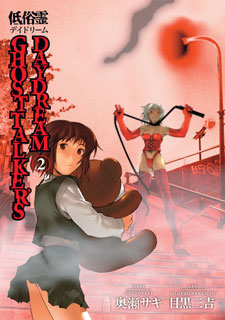
Manga Spotlight: Ghost Talker's Daydream Volume 2 Released by Dark Horse Manga Written by Saki Okuse Illustrated by Sankichi Meguro
While manga tends to be the work of one creator (with uncredited assistants), this column has recently featured a number of horror titles produced by writer/illustrator partnerships. Add Ghost Talker's Daydream to the list. Further grouping the targets, like MPD Psycho and Goth, it's a Shonen Ace title. I'm not going to pretend that I have anything approaching the skills or perspective of a Shonen Ace, but I am going to make an assumption on what Shonen Ace selects for: anime tie-ins, anime spin-offs, the works of high profile creators (Mamoru Oshii's Kerberos omnibus and CLAMP's Angelic Layer) and the hard edged/salacious. Based on that, I can see how the sometimes comedy, horror Ghost Talker's Daydream fits into the Shonen Ace line-up. Maybe not through "sex, violence and sexual violence," but "sexual humor, supernatural violence and sexual violence." I come here not to trash Ghost Talker's Daydream, but to wish that crying women weren't next to gags about bad driving, that the sleazy bits went for more reality or that the skills in place were applied to other ideas. It would be wrong to apply the label of "mainstream" to manga concerning an albinistic dominatrix/ghost whisperer in the employ of the Livelihood Protection Agency (a sketchily capitalistic group that seems to be primarily focused on trouble shooting real-estate value). The manga certainly seems to relishes its disreputability, as expressed in jokes about pubic hair (or lack thereof), bondage and stalking. While it might be a function of being older than the Shonen Ace target audience, I feel that the pairing of Okuse Saki and Meguro Sankichi pushes Ghost Talker's Daydream into sanitized territory. As a matter of preference, I wish that the manga was pushed further past the line of good taste or more reserved in its use of disconcerting subject matter. People are getting shit on... boarding subway trains and travelling the city in a PTSD daze... They're covering their bodies with sutras, like the Kwaidan's "Hoichi the Earless" from which Milius's Conan the Barbarian borrowed. There are discovered suicides and forests haunted by the victims of a serial rapist-murderer. I wish it didn't all look so clean. Screw with the aesthetic a bit. Emphasize the abnormality. If Ghost Talker's Daydream did not look so routinely idealized, if it looked as sleazy and gross as it is, Ghost Talker's Daydream would be Takashi Miike-like supernatural comedy... Todd Solondz presents Ghost Busters or Chuck Palahniuk Scared Stupid. I was thinking through elements of the manga that would leave a strong impression if they were rendered in such a way as to be reminiscent of reality rather than reminiscent of manga. Then I recalled...the manga's heroine has albinism. So, I thought to myself, "that might be interesting to see presented in anime." Eventually, I remembered that there was a Ghost Talker's Daydream anime. I'd seen it, and it left the same impression as the manga. There are enough pail women in anime/manga, that Ghost Talker's Daydream didn't stand out in that regard. (If you think about what you're looking at, the cover to volume two actually does handle this in an effectively eerie manner). Then again, Meguro Sankichi is not a bad manga artist. His ability to draw mixed martial arts fighting is as good as it gets. With the blend of skill and savagery that is suggested when his characters throw down, striking, grabbing and twisting, Ghost Talker' Daydream's tussles torch plenty of dedicated fight manga in their evocativeness. Occasionally, there will be a few pages of strict seriousness, but, over the course of the manga these are the exception. Often through expressions, there are so many attempts at humor in Ghost Talker's Daydream that it takes on an air of zaniness. Some of these are quite chuckle worthy. In scenes such as the heroine playing a racing title on her Game Boy in a crowded subway terminal, Sankichi demonstrates a skillful pen when it comes to pantomime. The problem is that he takes a swing at humor so often, that the hit to miss ratio ends up terribly skewed against him. The manga is laugh at its protagonists and not joking about suicide or sexual crime. Ghost Talker's Daydream would be a far more daring and more tasteless manga if that was reverse. As it stands, it takes the premise of a dominatrix/medium and businessman/martial artist who’s afraid of spirits and uses cartooned expressions carry the notion that these are inherently funny. That the character wears garters and a corsets and that she has no pubic hair? In and off itself, that doesn't make me laugh... In the pointless wish department... Saki Okuse is best known for gory sci-fi gothic Twilight of the Dark Master. I'd love another sleazy modern based horror, but something that looked more decrepit. From Meguro Sankichi , I'd love to see a yakuza manga in the vein of a British gangster movie that is a bit violent, but not all together serious. In other words, there's a lot to recommend about Ghost Talker's Daydream. Unfortunately, those recommendable bits don't necessarily complement each other.
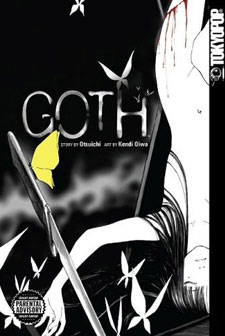
Manga Spotlight: Goth Story by Otsuichi Art by Kendi Oiwa Released by TOKYOPOP
"He has a tendency to constantly seek darkness in people, just like me. We crave cold, delicate aspects of human beings, like murder or torture. People like us are usually called GOTH. However, there's still a part of him that doesn't overlap me. People who like blood and guts are different from those who enjoy death cries." Goth offers the sick thrill of witnessing people tempt profound danger, akin to watching someone pet a lion. It's puts the "graphic" in graphic violence and looks on with interest. When revealed in the manga's post script, it's not entirely surprising to learn that Goth was partially inspired by an Angelina Jolie profile's reference to her collection of execution equipment. The manga's chronicle of twisted crimes works recursively, operating on the reader's dark fascination with people indulging in their own dark fascinations. Only, in this case, that dark fascination is not simply a tour of someone's knife collection. The Goth manga ran in Shonen Ace. This is an anthology that is largely known as a home for anime-to-manga adaptations, such as the manga incarnations of Samurai Champloo, Eureka 7, Blood+ and Neon Genesis Evangelion. Never the less, Shonen Ace manages to publish rather dark manga titles like Welcome to the NH and MPD Psycho. Like MPD Psycho, Goth's rabbit hole of serial killers desposits the reader into the midst of some severely grisly, decidedly explicit crime scenes. Last October (10.2.07), Variety reported that Splinter Cell game writer JT Petty had been tapped by Fox Atomic to write and direct a film based on Otsuichi's novel Goth. From Variety "Described as a gothic love story, the project revolves around two high school teens from opposite sides of the tracks who are forced to come together to take down a serial killer in their hometown." Well, that's vaguely like the novel that Kendi Oiwa adapted into manga. If you squint, their profiles kindof look similar. If you consider their full form, they seem profoundly different. It's as if someone suggested a Dexter adaptation premised as a police blood-splatter expert/outsider on a trail of a serial killer. Personally, I'm not taking bets on the likelihood of this Hollywood version of Goth coming to fruition, but I'd also say that a faithful adaptation would have as slim a probability of seeing the light of day as a faithful adaptation of Battle Royale. Goth might not be quite as incendiary as Rapeman or as outrageous as Violence Jack. However, a key aspect of its premise concerns teens seeking out and discovering grotesque crimes, not for the sake of justice or prevention, but to walk in the footsteps of killers and victims. The ostensible hero of the piece is collecting "souvenirs," like a knife shown cutting off a woman's breast, before her heart was removed and nailed to a tree along with her intestines and uterus. Regardless of whether or not the violence was recast as PG-13, there's an amorality and a sense in which the events are merely a confused preamble to the protagonists' own, dark adulthoods, that would never make it past studio decision makers. There's a theory that felines interpret the smell of catnip as a sort of super-prey. If that's the case, Yoru Morino could be called a catnip for human-predators, and one of the dark souls that she has attracted is classmate Itsuki Kamiyama. Kamiyama spent his childhood tearing apart dolls and painting "blood" on their faces. Consequently, he understands the ability to hide abnormalities. That ability to mask his passions and fit into normal social circles might explain why he was drawn to the "weird loner" Morino, whose demeanor of indifference is betrayed by scar across her wrist. When a "Wrist Cutter" begins terrorizing their community, Kamiyama decides to find the serial mutilator, stage a confrontation between the "Wrist Cutter" and Morino, then take her scarred wrist for himself. Though it's been published in English by TOKYOPOP, I haven't read the Goth novel. From what I understand of Otsuichi's (the pen name used by horror short story writer Hirotaka Adachi) original, it's an oblique work, mark by unexpected shifts in perspective. If the novel called to be pieced together, then the manga is more about enticing morbid curiosity. Kendi Oiwa adapts five of Otsuichi's six Goth shorts, with two of those stories conflated into the manga's finale. Especially in that double-shot ending, Goth calls attention to our lack of knowledge of exactly who we're watching or what we're seeing. In the manga version, there is some deception on the part of the author, and there is plenty of deception on the part of the subjects. However, it's rapidly moving, and symbolism laden imagery aside, it's largely objective. It might not be entirely explicit, but it's not punctuated in such a way as to encourage a consideration of the clues either. Rather than actively reasoning thorough the scenarios, the response to uncertainty is to read on, and maybe give matters a second though in retrospect. Part of the morbid voyeurism of Goth is a function of wanting to see Morino and Kamiyama act out their roles, but that's without the expectation of benefiting from the observation. Even if the stories build to a revelation of sorts, Goth never really upsets our notions of Morino and Kamiyama. Nor does it lead us to believe it would do otherwise. If you're watching a frog and a scorpion cross a river, you don't expect introspection on the far bank. Emphasize by its single volume length, the manga's point of interest isn't so much watching these characters evolve or reveal themselves, as it is watching their instincts in action. Beyond Goth's gorehound quotient, what's captivating about the manga is its leads' compulsion to dart into the path of atrocity. The average person might have the inclination to snap a quick look at a traffic accident, but Goth extrapolates that into a Cronenbergian obsession. Otsuichi and Kendi Oiwa are skilled at painting images of disturbing people in disturbing situations, but, to draw a contrast to Shonen Ace compatriot MPD Psycho and its creator Eiji Otsuka, there isn't really a social critic between the Otsuichi and Oiwa. Goth's violence is spectacle violence. It's effecting. It's chilling to read. But, it's not employed as a scalpel. There is a note of exploitation in the work. Goth's Morino is not entirely defenseless. One executing element of the characters' instincts is the way in which Morino responds to threats. That said, Goth has no compulsion against sexualizing peril. Morino is bound frequently and stripped once. The approach falls a bit closer to pulp mag woman-in-danger than erotic grotesque, but given a particular chapter illustration featuring Morino tied up in a corset/garters, blindfolded, gagged and collared, the intension is anything but ambiguous. In that sexual element, in maggots and mutilation, and in the character pathology, Goth is offering something at which to gape. There's no denying that it succeeds at this presumptive aim. It's not Hiroshi Hino or Suehiro Maruo, but there are specific panels that push the envelope about as far as it will go. The most significant lost opportunity might have been the chance to point a finger at the audience. The subject matter certainly opened the door for such an effort. Rei Hiroe's Black Lagoon manga is a stunning action series. Sunao Katabuchi's anime adaptation inherits the exhilaration of that violence, but also questions the characters, and by extension, the viewers response to violence. Witnessing the anime's gun blazing frontwoman do her thing, the anime's point of view character mutters "I don't know what broke to make her like this, but I must be broken too if I'm standing here praising her destructiveness," indicting himself and the viewer in the process. If Goth could have found a moment to step back and question itself... Goth wouldn't be the same if its characters, particularly Kamiyama, weren't so sure of themselves, but without directing its provocation towards any end, it loses some weight.

Manga Spotlight: Gun Blaze West Volume 1 By Nobuhiro Watsuki Released by VIZ Media
Between 1994 and 1999, Nobuhiro Watsuki wrote Rurouni Kenshin: Meiji Swordsman Romantic Story. The story of a political assassin from Japan's Meiji Restoration, who gave up killing in favor of the life of a wandering vagabond, ran 28 volumes. It spawned a 95 episode TV anime series, two direct to video OVA series, a movie and video games. It was a dominant manga title in Japan, Europe and the United States. Between 2003 and 2006, Watsuki wrote Buso Renkin. It was a moderate success. It ran 10 volumes. It spawned a 26 episode TV series and it had a following. In between, Watsuki created Gun Blaze West. Its Shonen Jump run was cancelled after three volumes. While it might be the case that Watsuki lost his magic (and his legendary assistants, such as One Piece's Eiichiro Oda and Shaman King's Hiroyuki Takei) when moving from Rurouni Kenshin to Gun Blaze West, it would be unjustifiably harsh to classify the manga as an outright failure. Kubo Tite's pre-Bleach Zombie Powder and Takeshi Obata's post-Death Note Ral Grad ran comparable four volume spans. While none of these could be classified as success stories in the shonen manga field, none are meritless either. Given that they're all far from the least entertaining manga that you can find, their abbreviated runs speak to the competitive field of Shonen Jump manga. Like Ruruoni Kenshin, Gun Blaze West takes a historical context, grabs tropes and flair from adventure manga, grabs a few style points from American super hero comics, and sends its hero out to discover a host of strange allies and foes. It starts in 1875 Wiston, Illinois "on the divide between east and west" before jumping a few years and pushing westward. The manga opens with young Viu Bannes defeating a larger older boy to win a gun belt. The immediate difference between the compositions of Gun Blaze West and Kenshin is that unlike Kenshin's warrior with a past, GBW features a younger wannabe, with guts compensating for lack of experience. Gun Blaze West features some of the great BANG! moments of Watsuki's work, such as a table being lifted to block a shot gun burst, where impact specs join the speedlines in exploding across the panel. If this represents a first exposure to Watsuki's illustration, the bursting quality might leave an impact. Unfortunately, Watsuki does not quite "make it work". In his, and maybe any, illustration style there is less room for error when attempting to make a gun look right than might be the case with a sword. If someone is holding a sword in an unusual fashion, that's an element of their exotic fighting style. If someone is firing with their elbow above their shoulder and their wrist turned such that the thumb is facing down, it just looks wrong. Consequently, "wow!" moments that offered a glimpse into something more in early Kenshin are replaced with "huh?" moments in GBW. Opening with a 9 year old winning a gun-belt offers a glimpse of one of the manga's difficulties. It's being marketed as a "Shonen Jump Advanced" title for an "older teen" audience. In a landscape in which Cartoon Network edits Gundam SEED, an anime broadcast at 10:30 pm, such that firearms look like Laser Tag pistol, it's understandable that a manga in which people bleed, are shot and stabbed, receives an "older teen" age recommendation. Yet, the manga stars a bright eyed kid who tries to jump kick armed raiders, who inherits the mission to seek out Gun Blaze West, a "Coliseum of the ancient natives" where "only the strong are allowed to set foot." Even after Viu has matured a bit, the manga feels like "Ash Ketchum Get Your Gun." It's hammy in a way that bounces around, but doesn't have the wonder or inspired goofiness that might encourage an older audience to think young, as might be the case with something like early Dragon Ball. If you're a content selector for a young manga fan and don't find a bit of shooting and bleeding too objectionable, Gun Blaze West might be an entertaining choice. If you're a Watsuki completist, you'll be pleased to find that the manga is perfectly alright, though not inspiring. Otherwise, if you lack for other options....
Digitally Distributed Anime
Anime Network content, Azumanga Daioh, Saiyuki and Mythical Detective Loki are now being offered though the vSNAX app for the the Apple iPhone and iPod touch. The shows are streamed as short three to five minute clips.* FUNimation Entertainment has acquired digital, broadcast, theatrical, DVD and merchandising rights to the13-episode supernatural anime series Shikabane Hime: Aka (Corpse Princess) from King Record Co. and now airing on Japan’s AT-X television. Starting Friday, October 24, Funimation will deliver high-quality, English subtitled streaming episodes of Gainax’s (Evangelion, Gurren Laggan) latest anime Shikabane Hime (Corpse Princess), through video-sharing partners YouTube.com, Joost.com and Hulu.com as well as www.funimation.com for free. FUNimation will also offer a download-to-own option for these episodes through www.funimation.com at $1.99 per episode.
ADV Reveils Future Plans
On October 20th, ICV2 posted a two part interview with A.D. Vision CEO John Ledford. During the interview, Ledford revealed the embattled distributor's ucpoming plans. We understand you have some new anime to announce? We do! We’re working with a new partner, Sentai Filmworks, which just acquired a number of anime titles. ADV is providing localization and some distribution services for Sentai. Some of what Sentai’s brought us will be familiar to fans. Mahoromatic and Mahoromatic: Something More Beautiful had been part of Geneon’s catalog, as was Tsukihime. Pet Shop of Horrors was first released years ago by Urban Vision. These are all great catalog titles that we’re going to help Sentai bring back to store shelves, beginning with a Mahoromatic collection in January. We’re also working with Sentai on a brand new series, Clannad. It’s a 24 episode teen comedy that did really well for TBS [the Japanese TV network]. North American fans have been waiting a long time for this. Sentai’s got the license, and ADV will bring out the first of six DVDs next April. We’ll have more announcements in coming weeks, both from Sentai and from Switchblade. According to ICV2, the dated/priced releases include: Clannad volume one of six will be released April 21, 2009. The anime is Kyoto Animation's (Haruhi Suzumiya) adaptation of a Key produced fantasy/romance eroge visual novel Robot maid comedy Indian Summer OVA Collection, which will be released on March 10th, 2009. Mahoromatic season one will be released January 13th for $44.98. Season two, Mahoromatic: Something More Beautiful Complete Set will be released on February 17th. The anime, other robot maid comedy, this one produced by Gainax, was previously released in North America by Geneon. Tsukihime will be released in January 20th. The anime, also released in North America by Geneon, is a vampire/supernatural drama based on a TYPE-MOON visual novel. Other planned releases include Pet Shop of Horrors OVAs (a bishonen horror anthology, previously released in North America by Urban Vision), and Jewel Bem Hunter Lime (a fantasy comedy, previously released in North America by Media Blasters).* The percise background of Sentai Filmworks has come up for some fan questioning. "nakimushi" offered a post on Anime on DVD's forum linking to filings that suggest Sentai Filmworks is a John Ledford company. Further speculation by former NewType USA Chris Johnston (FullmetalCJ) was posted online, including on the Anime News Network and Anime on DVD forums. Anime News Network notes that Sentai Filmworks is a newly established license holding company. Regarding the relationship between Sentai Filmworks and ADV Films, ADV representative Chris Oarr clarified "Sentai Filmworks is an entirely separate entity, a distribution client of ADV's. Switchblade Pictures is another." In early 2008, ADV Films' release schedule was shaken up when the distributor's relationship with Sojitz division ARM was disolved. A host of completed or ongoing ADV releases, including Air Gear, Devil May Cry, Guyver: The Bioboosted Armor TV, Kanon, Le Chevalier D'Eon and Red Garden were effected.
Upcoming North American Releases
AnimEigo AnimEigo has announced that they have begun shipping box sets of The Yawara Season 1 Box Set. Yawara, the Fashionable Judo Girl adapts the manga by Naoki Urasawa (Monster), concerning a Judo prodigy hoping to live a normal life despite presure to prepare for Barcelona's 1992 Olympic Games.* CMX JIHAI VOL.1 Written and illustrated by Toshimi Nigoshi After his childhood friend is killed, 17-year-old clone Aoi spends his last year to live looking for the man who killed him! As he searches for revenge, Aoi uses his ability to travel through the Jihai (wasteland), where supposedly nothing can survive, to act as a courier. After a routine delivery goes wrong, a pistol-packing padre named Tristram saves Aoi and takes him back to his home country — a place where clones are treated like people, not possessions. But Aoi quickly realizes something is amiss in this new land. What’s Tristram hiding, and will he be an ally in Aoi’s cause…or a threat? on sale February 11 - 194 pg, B&W $9.99 US - TEEN +CRAYON SHINCHAN VOL. 7 Written and illustrated by Yoshito Usui on sale February 25 - 128 pg, B&W, $7.99 US - MATURE THE FLAT EARTH/EXCHANGE VOL.3 Written and illustrated by Toshimi Nigoshi on sale February 4 - 224 pg, B&W $9.99 US - TEEN + DOROTHEA VOL. 4 Written and illustrated by Cuvie on sale February 18 - 164 pg, B&W, $12.99 US - MATURE READERS KIICHI AND THE MAGIC BOOKS VOL. 4 Written and illustrated by Taka Amano on sale February 4 - 160 pg, B&W, $9.99 US - TEEN THE PALETTE OF 12 SECRET COLORS VOL. 5 Written and illustrated by Nari Kusakawa on sale February 18 - 200 pg, B&W, $9.99 US - EVERYONE STEEL FIST RIKU VOL.3 Written and illustrated by Jyutaroh Nishino on sale February 11 - 178 pg, B&W, $9.99 US - TEEN + * Right Stuf Anime producer and distributor Right Stuf, Inc. and Nozomi Entertainment have rescheduled the release date of the EMMA: A VICTORIAN ROMANCE – Season 2 DVD Collection to November 11, 2008. The four disc set retails for $49.99 The two-week delay was caused by shipping delays, said Right Stuf President and C.E.O. Shawne Kleckner. He continued, “We know Emma fans have been eagerly awaiting its conclusion since the release of the Season 1 DVD Collection back in June. We thank you for your continued support and patience. And, most importantly, we look forward to delivering the rest of this exceptional series to you.” The Season 2 DVD Collection includes the 12 episodes of the series’ “Second Act,” plus “Episode 0: Intermission,” a recap/preview that aired prior to the start of the Season 2 telecast in Japan, and a 48-page “Victorian Gazette” that features artwork and illustrations from the series, plus an interview with EMMA creator Kaoru Mori.
Cool Figure News
BATMAN COSBABY MINI-FIGURES From DC/HOT TOYSUnder special arrangement with Hong Kong toymaker Hot Toys, DC Direct is delighted to offer the Batman line of CosBaby mini figures! Inspired by CosPlay (from the contraction of words “costume play”) — a type of performance art and role play in which the cosplayers meticulously outfit themselves in character costumes from sources such as manga, anime, comics, movies and video games to become the characters they emulate, reenacting scenes from the original sources — these Batman CosBaby mini-figures are the cutest little tykes around! Featuring eight Batman CosBaby designs: Batman Modern (Black Costume), Batman Classic (Blue Costume), The Joker, Robin, Batgirl, Catwoman, Two-Face and a special Mystery Figure, these mini-figures are the perfect size to collect and display! Packaged on a 4-color blister card, each fully assembled CosBaby stands approximately 3” tall. Advance-solicited; on sale June 24, 2009 PVC mini figures * PI * US UNI-FORMZ: BATMAN DESIGNED & SCULPTED BY MONSTER 5 Batman is the first in a new line of stylized vinyl UNI-FORMZ, inspired by the red-hot designer toy phenomenon! DC Direct has joined forces with popular contemporary toy designer Monster 5 to create this unique version of Batman. This bold new take on the Caped Crusader is a must-have for collectors of contemporary toy design, as well as traditional fans of Batman! Debuting this month are three styles of Batman: the “modern” Batman in his black costume, a variant version in the “classic” blue and gray costume, and an ultra-stylized variant “armored” version. These designer toys are limited! Once they are sold out, DC Direct will not produce these styles again! In keeping with the tradition of designer toys, rarity of certain incarnations are the norm. The Batman variants (“classic” and “armored”) will be produced in far lower quantities. The line of UNI-FORMZ continues in the months ahead with original designs for Superman, Green Lantern, and other favorite DC Universe characters. This limited-edition vinyl UNI-FORMZ Batman figure features 12 points of articulation, stands approximately 8” tall and is packaged in a deluxe 4-color window box. Advance-resolicited; on sale June 3, 2009 * Vinyl * PI * Gundam: The Last Battle of Soldiers of the Delaz Fleet (part one, two three) Phoenix Wright figures Transformer Disney HappySoda Figure Doujin 1 News Street Fighter Online Revoltech figures.
Anime x Games
Atari has released new screen shows of PlayStation 2's Dragon Ball Z: Infinite World and Dragon Ball: Origins for Nintendo DS. Both games will be releases on North America November 4th, retailing for $29.99 each.Dragon Ball Z: Infinite World combines elements from previous Budokai and Shin-Budokai series, as well as next-gen Dragon Ball Z: Burst Limit, with 40 unique characters for the "definitive" last "Z" title for the PlayStation2 computer entertainment system. Dragon Ball Z prequel Dragon Ball: Origins will follow young Goku and Bulma. Players control Goku in two modes: Combat and Power Pole mode. Each mode allows Goku a new set of enemy attacks to protect Bulma from incoming assaults while Bulmaís brains and her knack for inventing machines and weapons out of discarded spare parts help the formidable team to defeat the strongest of enemies and overcome the trickiest of obstacles. © 2008 BIRD STUDIO/SHUEISHA, TOEI ANIMATION. Licensed by FUNimation Productions, Ltd. All Rights Reserved. Dragon Ball, Dragon Ball Z, Dragon Ball GT, and all logos, character names and distinctive likenesses thereof are trademarks of TOEI ANIMATION. Developed by NAMCO BANDAI Games Inc. GAME: © 2007 NAMCO BANDAI Games Inc. Marketed and distributed by Atari, Inc., New York, NY. © 2008, Atari, Inc. All rights reserved. ATARI and the ATARI logo are trademarks or registered trademarks of Atari Interactive, Inc. or its affiliates. * Via SRW Hotnews Siliconera reports that Namco Bandai, the parent company of Banpresto, registered Endless Frontier in the US Patent and Trademark database. Endless Frontier is an original side story/spin-off of the mecha strategy RPG franchise* New screenshots on Magic Box Naruto: Narutimet StormGundam Musou/Dynasty Warriors Gundam 2 Yattaman Wii: Bikkuridokkiri Machine de Mou Race da Koron New Tatsunoko VS. Capcom : Cross Generation of Heroes trailer Subatomic Brainfreeze offers Super Robot Wars Z impressions Gundam VS Gundam Next * Noteworthy 1up coverage includes Bleach: Dark Souls (Nintendo DS) review Macross Ace Frontier (PSP) preview Gundam vs. Gundam (PSP) preview Dragon Ball Origins (Nintendo DS) preview Dragon Ball Z Infinite World (PS2) preview Bleach Versus Crusade (Wii) preview
The Business
Animation Insider reports that Toei Animation Co. has promoted and added to the executives in its L.A. office. As Animation Insider describe the move: "One of Japan's busiest and most noted animation production companies, Toei Animation, for many months now, has been pursuing potential co-production options with a variety of western nations. Earlier this month TOEI recognized that its immense draw in select western markets, more is needed. ...the animation group is looking to invest an even more than currently substantial amount of time and resources into developing international co-productions for dual audience bases. Due to Toei's size, their management team is already quite large, but the new business strategy will reportedly open doors for more revenue." Kozo Morishita will assumed the role of Chairman and CEO of the L.A animation group, in addition continuing to server as Managing Director at Toei Animation Co. (Japan). Kanji Kazahaya will be L.A's President and COO, in addition to continuing on as Director of International Department of Toei Animation Co. Meanwhile. Kenji Ebato will be Toei Animation's Executive Vice President and General Manager as well as Chief Manager of Licensing Sae Song was appointed to manage Toei Animation’s stateside digital media and mobile content operations.* Anime News Network reports that Sojitz Corporation will disssolve ARM by February 2009. The division was established to promote anime licensing and distribution in North America, and worked with ADV Films to release titles before ADV's breakup" with Sojitz. After the split, ARM transitioned its titles to FUNimation. Anime News Network editor-in-chief Christopher Macdonald posted on the sites forum I can't/won't get into why Sojitz and ADV split, let's just leave it at the very obvious "They didn't agree on the best way to run the business." Keep in mind that Sojitz still owns 20% of ADV. Until Sojitzor ADV find someone who wants to buy that 20%, or ADV has the cash to buy it back itself, that scenario will remain. Since ARM was created specifically for the purpose of acquiring licenses for ADV, there really is no purpose to keep ARM going now that it isn't working with ADV and the licenses have mostly been transferred to other companies. The likely outcome of this is...nothing. Funimation's licenses have already been, or will be transferred to licenses that go between Funimation and the Japanese rights holders for those titles. ARM was a go between and will simply be removed from the equation. The sad news is that a major potential investor in the North American anime market has come to the conclusion that there is no growth opportunity and wants to have nothing more to do with that market. With here FUNimation spokesperson Jackie Smith told Anime News Network "FUNimation no longer deals with ARM or Sojitz regarding the titles we acquired over the summer. Each title was transferred to us and we have been in direct contact with the licensers."* Screen Daily list the media that Japan's Hexagon Pictures brought to TIFFCOM. * Chocolate Underground, the anime film adaptation of Alex Shearer's children's novel Bootleg * Opera drama Pride (Jan 2009) which stars Death Note actress Hikari Mitsushima and is directed by Death Note director Shusuke Kaneko. * Female comedy Kanna's Big Success (Jan 2009) starring model-actress Yu Yamada and based on Yumiko Suzuki's manga which also spawned Korean hit 200 Pounds Beauty. * Amy Mori's romantic drama Days With You starring Erika Toda (L: Change The World) and Kazuki Kato. * High-Kick Girl, starring 17-year-old newcomer Rina Takeda as a deadly high school-aged karate black belt who gets caught up in a corrupt fight syndicate.* Hachette Book Group announced that the publisher will be creating a new division compresion of sci-fi imprint Orbit and manga imprint Yen Press. The new division will take the Orbit name. Hachette hopes that the new organization with "strategically strengthen HBG’s presence in these increasingly vital segments of the book buying market. " Tim Holman, who relocated from London to New York in 2006 to help set up Orbit, has been appointed VP and Publisher of the new division, reporting to CEO and Chairman David Young. Reporting to Tim Holman will be Kurt Hassler, Publishing Director of Yen Press. Kurt will be assuming responsibilities previously shared with co-Publishing Director Rich Johnson, who will be leaving the company at the end of October. Alex Lencicki has been appointed Marketing and Publicity Director for the new division.* ICV2 interviewed Dark Horse publishers Mike Richardson The Angry Otaku says It's the Economy Baka The relationship between Google Ads and Fansubs Ask John theorizes on "super nice anime" Japan's Summer DVD Sales ICV2 talks media carnage The Anime Almanac on The Optimism of FUNimation Entertainment Rocket Bomber looks back at the summer with Publishers' Scorecard Estimated Publisher Market Share Top 150 Series
DragonBall Reshoots
DragonBall - The Movie reports that the live action Dragonball film will recommence starting October 30th. A casting notice was sent out for people between the ages of 20-70 and are fluent in Nepalese or Tibetan. Speaking of live action adaptations Street Fighter: The Legend of Chun-Li posters
Event News
Dave Merrill will be presenting Anime Hell at Youmacon at the Hyatt Regency in Dearborn, Michigan Dr. Frenchy Lunning, professor of liberal arts and Fulbright scholar to Japan, will speak at the University of Arkansas – Fort Smith on November 19th “Japanese Anime and American Animation Industry” is the topic for Dr. Frenchy Lunning, professor of liberal arts and Fulbright scholar * Medium at Large notes Manga For Dummies author Kensuke Okabayashi friends at Kinokuniya Bookstore (1073 Ave of Americas) in NYC at 3 PM on October 25. Okabayashi will be presenting a reading and demonstration followed by a signing.* LA's New Beverly Cinema will be the live action adaptation of violent martial arts manga Riki-Oh: The Story of Ricky on Halloween.* The New York International Children Film Festival will be present the New York debut of THE BOY IN THE STRIPED PAJAMAS Tuesday, October 28, 6:30pm at IFC CenterPOST-FILM DISCUSSION AND AUDIENCE Q&A WITH: AUTHOR, JOHN BOYNE DIRECTOR/SCREENWRITER, MARK HERMAN ACTOR, DAVID THEWLIS (Professor Lupin in the Harry Potter movies.) RECOMMENDED AGES 10 AND UP THE BOY IN THE STRIPED PAJAMAS UK, Mark Herman, 2008, 93 min Based on the best-selling story by Irish novelist John Boyne, this beautifully shot and moving film offers a unique perspective on how prejudice and hatred affect innocent people during wartime. Through th

